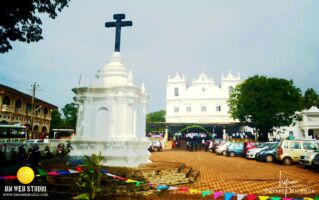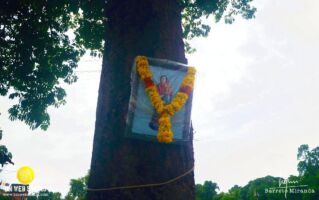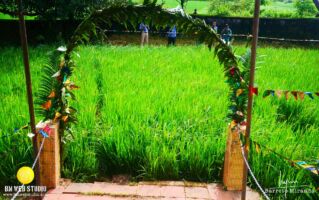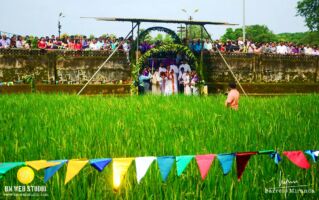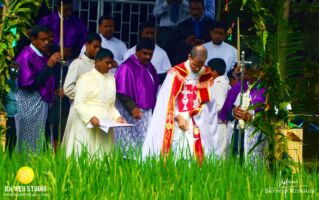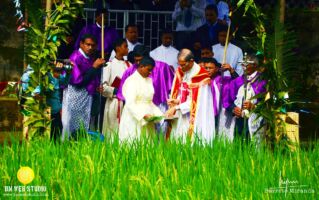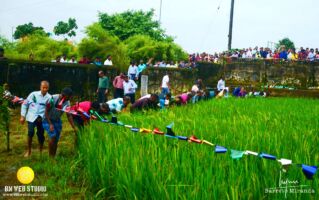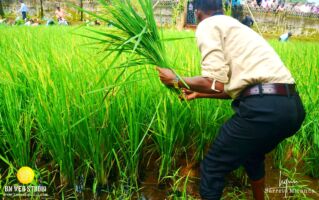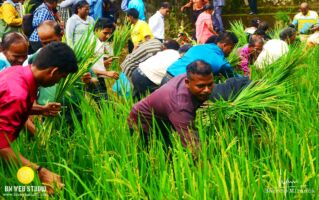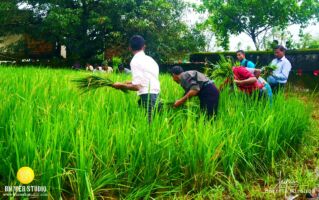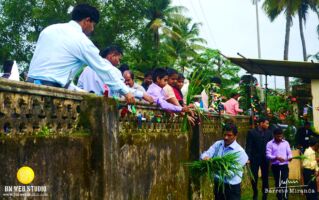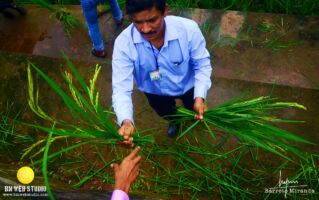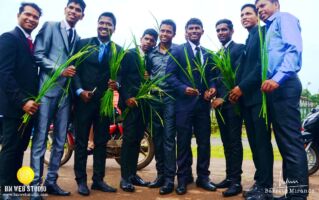Konnsanchem Fest (Harvest Festival)
The Harvest Festival is celebrated all over the world in different ways and our little state is no exception. In Goa, the festival is celebrated in almost all villages as a sign of gratitude to the Almighty for bestowing the farmers with a bountiful harvest.
Steeped in history – Raia, Taleigao, Aldona, Salvador do Mundo and Divar – five hotspots of the celebration come into prominence during the monsoon with some unique customs.
Every year at the peak of the monsoon season, Salcete taluka’s Raia has the distinction of being the first village in the state to ring in the harvest ceremonial every year on August 5. It’s a tradition that goes back over 300 years. With a silver sickle said to have been sent all the way from Rome by the Pope, the parish priest symbolically cuts the sheaves (konsa) of rice harvest. Farmers from several villages congregated here to attend the service and ensuing festivities which also draws hundreds of Hindu and Christian devotees from all round the state. The blessed sheaves are now not sent to the governor nor the bishop of Goa, but only to the neighbouring Rachol seminary.
Next to follow are the celebrations in Bardez taluka; the villages of Aldona and Salvador do Mundo celebrate it on August 6. The Aldonkars also commemorate the Feast of Transfiguration of Jesus on that day, as do the Saloikars, who honour their patron, the Saviour of the World. On this day, a procession leads from the church to the field opposite where the fresh paddy has been harvested, carrying a statue of the Saviour of the World. The statue has a golden sickle in its hand, which was presented by the Athaide family over a century ago and is used symbolically by the priest to harvest paddy.
Taleigão celebrates the feast on August 21, the tradition dating back almost 500 years entrusts the honour of celebrating the feast to only nine families, by turn. In the 16th century, the Portuguese bestowed upon this village the privilege of being the first in Tiswadi taluka to cut and have the corn blessed, before presenting it to the governor. The honour was in recognition of the sacrifices of nine families who had provided food to soldiers after Afonso de Albquerque’s forces were defeated in battle by the army of Adil Shah.
On the first day of its four-day celebration, a male member of one of the nine vangors (families) Mendonca, Viegas, Martins, Luis, Gomes, Faria, Almeida, Falcao and Abreu cuts the corn. Following the thanksgiving mass, the ‘president of the feast’ leads a group of people carrying the corn to the Governor’s Palace in Dona Paula, before returning home for a sumptuous lunch. The distribution of fov (pressed rice) among the villagers and the celebration of a mass at Old Goa are some of the traditions performed over the next three days. While the traditional dhirios have been stopped, after a ban on bullfights in 1998, the traditional dance ‘Addão’ performed by tribal farmers wearing colourful costumes, has also been discontinued.
On the island of Divar the event is celebrated by a procession of flags, popularly known as Bonderam, and two comunidades – Goltim-Navelim and Naroa-Malar celebrate the festival on separate weekends.
Our Lady of Snows Church in Raia
The Our Lady of Snows Church in Raia was erected in 1699, around six kilometres from the commercial centre of Margao. Raia has the same patron as the church of its neighbouring village of Rachol, that of Nossa Senhora Das Neves established by the same Jesuit priests. The foundation for the church was laid in 1668 and was built through the efforts of the Raia and Camurlim communidade.
The legend of the patron is quite interesting. The narrative, which dates back to the 15th century, is told as follows in a calendar issued by the Our Lady of Snows Church in Raia a few years ago. There was no snowfall in Italy and people were faced with adverse situations. They were unable to bear the continuous scorching weather. In their perplexity and utter helplessness they prayed with great faith and vowed to build a church at a place where snow would fall. Their fervent prayers were answered and to their relief it began snowing. The villagers, in keeping with the vow, constructed a church on the top of a hill and named is Our Lady of Snows Church.
The Our Lady of Snows Church was the first church in Salcete to be named ‘Snows’ church. The people of Raia had no separate church till 1668 and the faithful had to travel all the way to the Rachol Church and the Jesuits College (Rachol Seminary) to celebrate the feast.
Concerned about the growing Christian population at Raia, a Jesuit priest named Fr Jorge Caldeira began corresponding with the Portuguese government, emphasising the necessity for a separate church. The government agreed to this idea, allowing the magnificent new Raia church to be built. Today, Raia is a village not only flowing with abundant lush greenery, hills and fields, but is also spiritually blessed with six chapels, the SVD Mission Seminary – an international religious missionary congregation, the Pedro Arrupe Institute (PAI) of the Jesuits, a centre for religious formation, St Theresa’s Convent, and Kalyani Bhavan, a home for the senior ladies in Solva managed by the Handmaids of Christ.
The feast of Our Lady of Snows, also known as the Konnsanchem fest, marks the beginning of harvest season. The feast is also observed in the Rachol Church, however it takes place a week later. Raia, being the first village to harvest paddy, the feast draws people from all around Salcete. The harvest feast has biblical significance too, as in the book of Genesis, Abel offers his best sheaves of corn to God as a sacrifice.
The blessing and cutting of the konsam (sheaves) in the paddy fields is the climax of the feast liturgy. The parish priest blesses the new harvest, wishing all farmers a happy harvest and a good yield for their hard work. It is a special moment where a large crowd of parishioners gather to witness this momentous blessing. The procession and distribution of konsam for all worshippers concludes the liturgy. Much faith is witnessed towards the patron Neves Saibinn as people of all communities attend the konsamchem fest.
A football match is arranged among the local clubs in keeping with the custom of village feasts. After the match, the much-anticipated lucky draw is held, capping off a full day of celebrations.
* Photos are of the Konsamchem Fest held at Raia in 2016.
Photos by Lynn Barreto Miranda / lynn.barretomiranda.com

Scan the code for directions.

website designed by bmwebstudio
goa / ph: 9822151419


